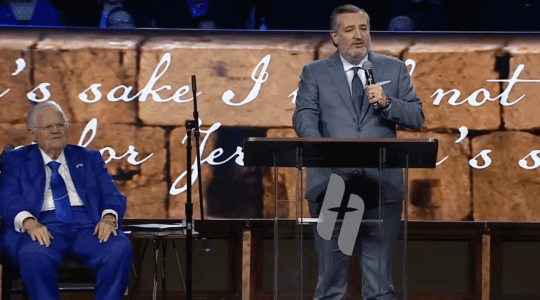NEW YORK (JTA) – Jewish organizations are generally failing to attract financial support from America’s wealthiest and most philanthropic Jews, according to a report by the Institute for Jewish and Community Research.
The study released Tuesday showed that Jews gave 12 percent of all gifts of $1 million or more donated to nonprofit organizations between 2001 and 2003, but only 9 percent of these Jewish donations were directed toward Jewish organizations.
Of the $10 million-plus gifts by Jewish donors, only 5 percent went to Jewish groups – down from 6 percent between 1995 and 2000, the last period studied by the San Francisco-based institute.
Its president, Gary Tobin, said the low rate of “mega-gifts” to Jewish organizations does not reflect poorly on the generosity of Jewish donors – their general level of giving is on par with their wealthy non-Jewish peers.
Instead, Tobin argued, Jewish organizations are not effectively reaching out to the ultra-wealthy.
“The conclusion I draw is that Jewish organizations are not effectively making their case,” Tobin said, “whether that is in terms of not asking for enough or not making compelling arguments or getting access to the donors.”
The institute is also looking at the years 2004-07, but the preliminary data show a similar picture.
That is despite a slew of major gifts to Jewish causes that includes the $100 million gift to Yeshiva University from fertilizer magnate Ronald Stanton; the $75 million gift to Hadassah Hospital from Detroit Pistons’ owner William Davidson; the $100 million gift to the Technion-Israel Institute of Technology from aerospace entrepreneur Alfred Mann; and the nearly $60 million given to birthright israel in the past year by casino mogul Sheldon Adelson.
Jews tend to give their gifts of more than $10 million to higher education, the arts and health care, according to the study:
* Fifteen gifts totaling $1.6 billion went to the arts, including a $1 billion donation from the Annenberg Foundation to the Metropolitan Museum of Art in New York City.
* Thirty-two mega-gifts totaling $1.6 billion went to private higher education.
* Sixteen gifts totaling $649 million went to public higher education.
* Thirteen gifts totaling $247 million went to health care.
By comparison, during that time frame, Jewish philanthropists made just 11 gifts of $10 million or more totaling $269 million to Jewish causes.
That, Tobin said, is probably a generous estimate, as he and his researchers were lenient in classifying Jewish causes.
For example, they counted the $25 million that investor Michael Price gave to the Albert Einstein College of Medicine of Yeshiva University in 2002. While Einstein is the medical school of Y.U., aside from serving kosher food and closing on Jewish holidays, it generally resembles a conventional medical school.
Researchers also counted two $32 million allocations that the Avi Chai Foundation distributed to its Israel offices in 2002 and 2003.
None of the Jewish gifts of more than $10 million went to local Jewish federations, human service organizations or religious institutions.
Jewish organizations did fare better when it came to gifts between $1 million and $9.9 million. About 30 percent of the money from those Jewish gifts went to higher education, but Jewish groups netted about 19 percent, pulling ahead of causes associated with the arts and health.
Jewish federations received 1 percent of those gifts, the largest of which was a $6 million donation in 2003 to the Associated: Jewish Community Federation of Baltimore.
The bottom line, Tobin said, is that Jewish groups have not capitalized on Jewish wealth. Whereas universities, museums and hospitals have dedicated resources to perfecting the art of courting the mega-gift, Jewish groups have failed to do so.
“The federations got some of the $1 million to $10 million gifts, but outside of capital campaigns you just don’t see” those donations, he said. “It is not about identity; it is about structure and fund-raising techniques.
“It is an indictment upon everyone. The Jewish organizations are failing to attract major gifts, period. It is a systematic problem in Jewish philanthropy, not just with federations.”
Richard Marker, an independent philanthropy adviser and a professor of philanthropy at New York University, warned that Tobin’s data may not be an indictment of either the Jewish philanthropists or Jewish organizations.
Rather, he said, the findings reflect that American Jews – especially those younger than 45 – do not rely on institutional affiliations to define themselves Jewishly. Their giving to non-Jewish organizations, therefore, cannot be seen as a blanket rejection of Jewish organizations.
“I don’t think it is an institutional problem,” Marker said. “I think it is a definition of the way in which the Jewish community sees itself in an open society.
“A person who supports a university that has Jewish studies may feel they are better supporting Jewish life in America than they could by supporting a day school.If someone gives money to Harvard, the University of Pennsylvania, Cornell, UCLA or Northwestern, they can say, ‘My goodness, look at this university where people can get kosher food and be shomer Shabbat. Why am I not supporting a vision of Jewish life in American society?’ “
Marker said Jewish groups tend not to reflect a broad vision of what it means to be a Jewish member of American society and reaching out to mega-donors by pitching a charity as a Jewish obligation may not work.
“At $10 million, guilt-tripping doesn’t cut it,” he said. “And it may be true that Jewish institutions have not been able to present themselves as having a broad enough mandate that it becomes exciting to give at those levels.”
JTA has documented Jewish history in real-time for over a century. Keep our journalism strong by joining us in supporting independent, award-winning reporting.





